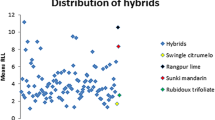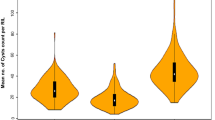Abstract
This paper reports on the strategy being used to study chickpea (Cicer arietinum) quantitative trait loci (QTL) conferring resistance to the necrotrophic fungal pathogen Ascochyta rabiei. The three chickpea linkage groups (LG), harbouring six QTL conditioning resistance against A. rabiei, were compared with the most comprehensive chickpea map (W-Ca-LG) and to the orthologous pseudochromosomes of the legume model plant Medicago truncatula. QTL1 was located in the subcentromere region of the chickpeaW-Ca-LG3 (chromosome C) and on the short arm of the M. truncatula pseudochromosome 7. QTL2 and QTL3 were located on the long arm of the W-Ca-LG8 (chromosome H) and on the short arm of the M. truncatula pseudochromosome 5. QTL4, QTL5 and QTL6 were located in the subcentromere region of the W-Ca-LG4 (chromosome B) and in a similar location of the M. truncatula pseudochromosome 1. To further delimit the genomic regions where the QTL were located, 25 legume expressed sequence tags (ESTs), which were shown to be upregulated in resistant chickpea accessions challenged with A. rabiei, were selected and BLASTed against M. truncatula genome sequences using a chromosome visualisation tool. Eleven of the 25 ESTs were mapped in silico on the nine M. truncatula pseudochromosomes with 1–4 copies. The association of mapped ESTs with chickpea resistance to A. rabiei requires further characterisation.
Similar content being viewed by others
References
Ane JM, Kiss GB, Riely BK, Penmetsa RV, Oldroyd GE et al. (2004) Medicago truncatula DMI1 required for bacterial and fungal symbioses in legumes. Science 303, 1364–1367. doi: 10.1126/science.1092986
Arumuganathan K, Earle ED (1991) Nuclear DNA content of some important plant species. Plant Molecular Report 9, 208–218.
Bennetzen JL, Freeling M (1997) The unified grass genome: synergy in synteny. Genome Research 7, 301–306.
Bian XY (2001) ‘Towards cloning the self-incompatibility genes from Phalaris coerulescens.’ (The University of Adelaide: Adelaide)
Bian XY, Friedrich A, Bai JR, Baumann U, Hayman DL, Barker SJ, Langridge P (2004) High-resolution mapping of the S and Z loci of Phalaris coerulescens. Genome 47, 918–930. doi: 10.1139/g04-017
Cho SH, Chen WD, Muehlbauer FJ (2004) Pathotype-specific genetic factors in chickpea (Cicer arietinum L.) for quantitative resistance to Ascochyta blight. Theoretical and Applied Genetics 109, 733–739. doi: 10.1007/s00122-004-1693-x
Choi HK, Mun JH, Kim DJ, Zhu HY, Baek JM et al. (2004) Estimating genome conservation between crop and model legume species. Proceedings of the National Academy of Sciences of the United States of America 101, 15289–15294. doi: 10.1073/pnas.0402251101
Coram TE, Pang ECK (2005a) Isolation and analysis of candidate Ascochyta blight defence genes in chickpea. Part I. Generation and analysis of an expressed sequence tag (EST) library. Physiological and Molecular Plant Pathology 66, 192–200. doi: 10.1016/j.pmpp.2005.08.003
Coram TE, Pang ECK (2005b) Isolation and analysis of candidate Ascochyta blight defence genes in chickpea. Part II. Microarray expression analysis of putative defence-related ESTs. Physiological and Molecular Plant Pathology 66, 201–210. doi: 10.1016/j.pmpp.2005.08.002
Coram TE, Pang ECK (2006) Expression profiling of chickpea genes differentially regulated during a resistance response to Ascochyta rabiei. Plant Biotechnology Journal 4, 647–666. doi: 10.1111/j.1467-7652.2006.00208.x
Devos KM, Gale MD (2000) Genome relationships: the grass model in current research. The Plant Cell 12, 637–646. doi: 10.1105/tpc.12.5.637
Flandez-Galvez H, Ades PK, Ford R, Pang ECK, Taylor PWJ (2003) QTL analysis for Ascochyta blight resistance in an intraspecific population of chickpea (Cicer arietinum L.). Theoretical and Applied Genetics 107, 1257–1265. doi: 10.1007/s00122-003-1371-4
Gualtieri G, Kulikova O, Limpens E, Kim DJ, Cook DR, Bisseling T, Geurts R (2002) Microsynteny between pea and Medicago truncatula in the SYM2 region. Plant Molecular Biology 50, 225–235. doi: 10.1023/A:1016085523752
Krutovsky KV, Troggio M, Brown GR, Jermstad KD, Neale DB (2004) Comparative mapping in the Pinaceae. Genetics 168, 447–461. doi: 10.1534/genetics.104.028381
Lan TH, Paterson AH (2001) Comparative mapping of QTLs determining the plant size of Brassica oleracea. Theoretical and Applied Genetics 103, 383–397. doi: 10.1007/s001220100615
Levy J, Bres C, Geurts R, Chalhoub B, Kulikova O et al. (2004) A putative Ca2+ and calmodulin-dependent protein kinase required for bacterial and fungal symbioses. Science 303, 1361–1364. doi: 10.1126/science.1093038
Millan T, Rubio J, Iruela M, Daly K, Cubero JI, Gil J (2003) Markers associated with Ascochyta blight resistance in chickpea and their potential in marker-assisted selection. Field Crop Research 84, 373–384. doi: 10.1016/S0378-4290(03)00103-5
Millan T, Clarke HJ, Siddique KHM, Buhariwalla HK, Gaur PM, Kumar J, Gil J, Kahl G, Winter P (2006) Chickpea molecular breeding: new tools and concepts. Euphytica 147, 81–103. doi: 10.1007/s10681-006-4261-4
Nishimura R, Hayashi M, Wu GJ, Kouchi H, Imaizumi-Anraku H et al. (2002) HAR1 mediates systemic regulation of symbiotic organ development. Nature 420, 426–429. doi: 10.1038/nature01231
Pande S, Siddique KHM, Kishore GK, Bayaa B, Gaur PM, Gowda CLL, Bretag TW, Crouch JH (2005) Ascochyta blight of chickpea (Cicer arietinum L.): a review of biology, pathogenicity, and disease management. Australian Journal of Agricultural Research 56, 317–332. doi: 10.1071/AR04143
Paterson AH, Wing RA (1993) Genome mapping in plants. Current Opinion in Biotechnology 4, 142–147. doi: 10.1016/0958-1669(93)90114-C
Phan HTT, Ellwood SR, Ford R, Thomas S, Oliver R (2006) Differences in syntenic complexity between Medicago truncatula with Lens culinaris and Lupinus albus. Functional Plant Biology 33, 775–782. doi: 10.1071/FP06102
Schmidt R, Acarkan A, Boivin K (2001) Comparative structural genomics in the Brassicaceae family. Plant Physiology and Biochemistry 39, 253–262. doi: 10.1016/S0981-9428(01)01239-6
Taylor PWJ, Ford R (2006) Chickpea genome mapping. In ‘Genome mapping and molecular breeding in plants. Vol. 3. Pulses, sugar and starch crops’. (Ed. C Kole) pp. 109–121. (Springer: Heidelberg)
ten Hoopen R, Harbord RM, Maes T, Nanninga N, Robbins TP (1998) The self-incompatibility (S) locus in Petunia hybrida is located on chromosome III in a region, syntenic for the Solanaceae. The Plant Journal 16, 729–734. doi: 10.1046/j.1365-313x.1998.00336.x
Winter P, Benko-Iseppon AM, Huttel B, Ratnaparkhe M, Tullu A et al. (2000) A linkage map of the chickpea (Cicer arietinum L.) genome based on recombinant inbred lines from a C. arietinum × C. reticulatum cross: localization of resistance genes for fusarium wilt races 4 and 5. Theoretical and Applied Genetics 101, 1155–1163. doi: 10.1007/s001220051592
Young ND, Cannon SB, Sato S, Kim D, Cook DR, Town CD, Roe BA, Tabata S (2005) Sequencing the genespaces of Medicago truncatula and Lotus japonicus. Plant Physiology 137, 1174–1181. doi: 10.1104/pp.104.057034
Zhu HY, Choi HK, Cook DR, Shoemaker RC (2005) Bridging model and crop legumes through comparative genomics. Plant Physiology 137, 1189–1196. doi: 10.1104/pp.104.058891
Author information
Authors and Affiliations
Corresponding author
Rights and permissions
About this article
Cite this article
Bian, X.Y., Ford, R., Han, T.R. et al. Approaching chickpea quantitative trait loci conditioning resistance to Ascochyta rabiei via comparative genomics. Australasian Plant Pathology 36, 419–423 (2007). https://doi.org/10.1071/AP07044
Received:
Accepted:
Issue Date:
DOI: https://doi.org/10.1071/AP07044




